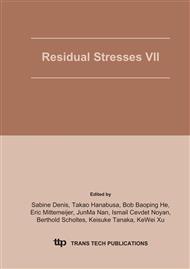p.1
p.7
p.13
p.19
p.28
p.29
p.35
p.41
Application of X-Ray and Neutron Diffraction Methods to Reliability Evaluation of Structural Components and Electronic Device
Abstract:
In the X-ray diffraction method, the diffraction intensity, the half-value width, the residual stress and the amount of residual austenitic phase can be measured. By using these parameters, the quality, the mechanical properties and the fatigue strength of materials, the remaining life of fatigue and creep can be evaluated. While the X-ray study has been widely performed for the various kinds of industrial fields in the laboratory, the applications to the actual structure and components have not so many. However, the small size X-ray residual stress analyzer, the position sensitive detector and the micro area diffraction apparatus have been developed for these twenty years. Thus the X-ray diffraction methods have been variously applied to the industrial fields. The X-ray diffraction methods were used to be applied for the large scale structures and machine parts, but recently applied to the semi-conductor fields. On the other hand, the neutron diffraction method has been introduced to measure the residual stresses in the internals of components because of its deep penetration depth. Based on the experiences of X-ray diffraction method, the various kinds of techniques have been proposed. In this paper, the applications of X-ray and neutron diffraction method to the reliability evaluations of structural components and the electronic devices are described.
Info:
Periodical:
Pages:
19-27
Citation:
Online since:
July 2005
Authors:
Keywords:
Price:
Сopyright:
© 2005 Trans Tech Publications Ltd. All Rights Reserved
Share:
Citation:


